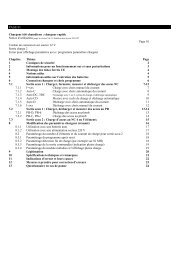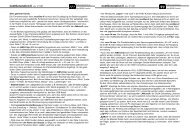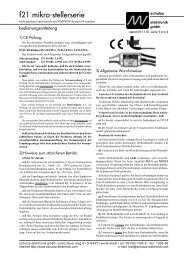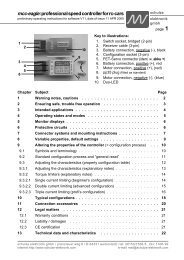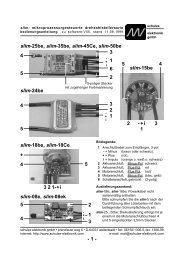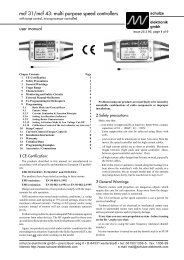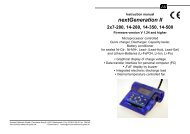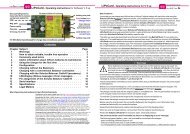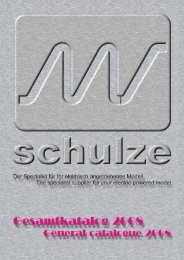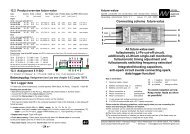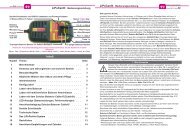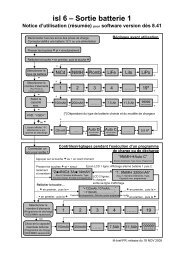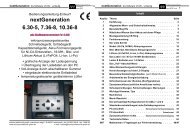ecolader: rapid discharger/charger series - Schulze Elektronik GmbH
ecolader: rapid discharger/charger series - Schulze Elektronik GmbH
ecolader: rapid discharger/charger series - Schulze Elektronik GmbH
You also want an ePaper? Increase the reach of your titles
YUMPU automatically turns print PDFs into web optimized ePapers that Google loves.
Page 30 <strong>ecolader</strong>: <strong>rapid</strong> <strong>dis<strong>charger</strong></strong>/<strong>charger</strong> <strong>series</strong><br />
11* Data interface<br />
The <strong>ecolader</strong> select transfers important charge<br />
and discharge data to the PC at one-second<br />
intervals when "on-line".<br />
To receive and analyse the data your PC must<br />
be loaded with our winsoft software, and<br />
the <strong>ecolader</strong> select must be connected to<br />
the PC using our interface cable (isl 8-<br />
RS232). Both are included with the <strong>ecolader</strong><br />
select.<br />
The following data is transferred:<br />
battery number,<br />
charge time in seconds,<br />
charge / discharge voltage in mV,<br />
charge / discharge current in mA,<br />
Temperature of the temperature sensor.<br />
If only Battery 1 is connected, the voltages are<br />
also transferred which are picked up by the<br />
8 measurement wires:<br />
Cell 1... cell 7 and the<br />
overall voltage of all the cells.<br />
The <strong>ecolader</strong> select also transfers a special set<br />
of incidental data at the start of the charge<br />
or discharge process, including the name of<br />
the program in use, date, time of day and<br />
cell count...<br />
The exact data format and pin-outs for the interface<br />
connector are shown in the Specification<br />
in Section 14.<br />
12* "winsoft" Windows®<br />
Software<br />
Using winsoft you can receive data from the<br />
<strong>ecolader</strong> select and the isl 8 (a <strong>charger</strong> /<br />
<strong>dis<strong>charger</strong></strong> for up to 36 cells, specially designed<br />
for model aircraft use), and store the<br />
information globally or selectively for each<br />
battery in files in the computer. You can<br />
then read in the data again, display it in<br />
graphic form, compare graphs with each<br />
other on-screen, normalise voltages for the<br />
cell count, smoothe curves, select combination<br />
program curves from an on-line data<br />
file, display energy statements for batteries,<br />
print out graphs (in colour), and much more.<br />
It is also possible to export the data to a<br />
spreadsheet program for further processing.<br />
The Windows software runs on any computer<br />
using Microsoft DOS 6.22 and Microsoft<br />
Windows für Workgroups 3.11; it also usually<br />
runs correctly with the immediate predecessor<br />
versions.<br />
Installation instructions are included in the<br />
readme.txt file on the 3.5" diskette supplied<br />
with the <strong>charger</strong>.<br />
The operating instructions for our winsoft analysis<br />
program is integrated into the software's<br />
Help texts, which can also be printed<br />
out from within the program page by page.<br />
Home-made selection device for individual cells (see Section 10.6)<br />
to + Batt. 1 charge socket to - Batt. 2 charge socket<br />
Detail enlargement, + terminal<br />
Detail enlargement, - terminal<br />
schulze elektronik gmbh • prenzlauer weg 6 • D-64331 weiterstadt • tel: 06150/1306-5, fax: 1306-99<br />
internet: http://www.schulze-elektronik.com e-mail: mail@schulze-elektronik.com



